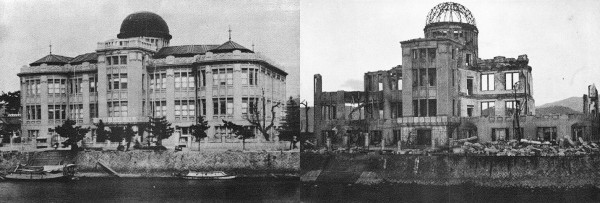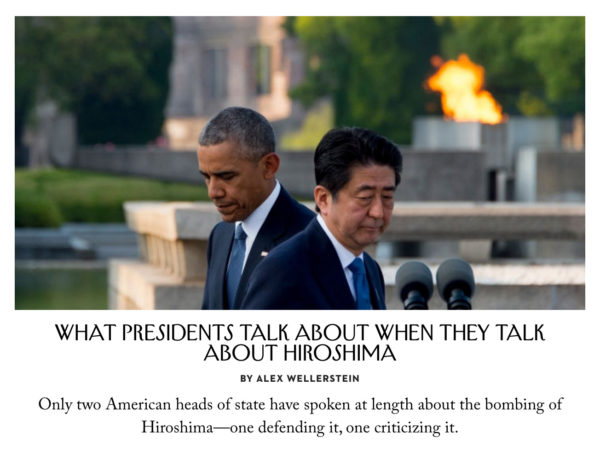The big nuclear news this week was President Obama’s visit to Hiroshima. Obama is the first sitting-President to visit the city (Carter and Nixon visited it after their terms were up). The speech he gave is more or less what I thought he was going to say: a short discussion (with heavy reliance on passive voice) on the bombings (they just sort of happened, right?), a vague call to make a world without nuclear weapons and war, a invocation of a lot of standard nuclear age stereotypes (humanity destroying itself, needing to be smart in ways that are not just about making weapons, etc.).
I’m not criticizing the speech — it’s fine, for what it is. There is nothing that the President could really say that would be enormously satisfying, no matter what your position on nuclear weapons is, or what your position is on him as a President. He wasn’t going to apologize for the bombings, he wasn’t going to justify the bombings, he isn’t going to make nuclear weapons (or war) disappear overnight. Such are the realities of our present political discourse and state of the world. I think it’s a good thing that he went. The speech is an exercise in compassion and empathy. That’s never a bad thing. The one thing I would press him on, if I got to do so: he uses the word “we” a lot (e.g., “How easily we learn to justify violence in the name of some higher cause“). Who is this “we”? Is it a narrow “we,” a national “we,” a human “we”? I think the latter — but the danger of using that inclusive a “we” is that it assigns no real responsibility. If he wants the things that he says he does, he needs to narrow down the “we” a bit, to start talking about who, specifically, is going to accomplish those things.
I was asked if I would write something with a historical slant on it about his visit. It is now up at the New Yorker’s website: “What Presidents Talk about When the Talk About Hiroshima.” I went over every public discussion of Hiroshima or Nagasaki that I could find from US Presidents. By and large, they don’t talk about them much, or if they do, it’s in a very brief and often vague context. Ronald Reagan actually gave an address on its anniversary in 1985 but managed to say really nothing about it; a year later he invoked Hiroshima in defense of the Strategic Defense Initiative. In his farewell address, Jimmy Carter invoked Hiroshima in a rather generic way to talk about the specter of nuclear war. And so on. 1
The only two Presidents who spilled much ink on the topic of the history, perhaps not surprisingly, were the two who had the most proximity to the event (aside from Roosevelt, of course, who died before the atomic bomb was non-secret, and left very little record as to his thoughts about its possible use before his death), Harry Truman and Dwight Eisenhower. It’s an interesting pairing in that Truman was, as one would expect, very much interested in making sure the historical record saw his work as justified. He, along with Henry Stimson and Leslie Groves took part in an active campaign to push a specific version of the story, namely the “decision to use the bomb” narrative (in which Truman deliberated and weighed the decision and decided to order the bombing). This version of things is pretty universally rejected by historians today — it just isn’t what happened. There was no single decision to use the bomb, there was no real debate over whether it should be used, and Truman wasn’t that central to any of it. It’s a retrospective narrative made to streamline the issues (e.g. “bomb or invade,” which makes bombing look like the only acceptable answer and obscures any possibility of alternatives), and reinforce a postwar notion about the responsibility of the President (e.g. the bombing as a political decision, not a military one). One can still support the use of the bombs without subscribing to this particular version of the story.

The “Atomic Bomb Dome,” before and after the bombing of Hiroshima. I find this particular picture very striking, because without the “before,” the extent of the “after” is hard to make sense of. More of these on-the-ground before-and-after photos can be found here, along with the source information.
Eisenhower’s views for many will be the more surprising of the two. At various points both before and after (but not during) his Presidency he published some very strongly-worded statements implying that the bombings were morally wrong, unnecessary, and that he had objected to them. These are often marshaled by historians today who want to argue that the bombings weren’t necessary. The thing is, this narrative is really flawed as well. Barton Bernstein did a compelling job (decades ago) in demonstrating that there is no real evidence for Eisenhower’s later accounts of his dissent, and that it is pretty unlikely that things happened the way Eisenhower said they did. 2
Today I think we can read Eisenhower’s feelings on the bomb through the lens of how the postwar military viewed the public perception of the atomic bomb having “ended the war” — they were being robbed of the credit for all of the difficult (and destructive) work the conventional forces did. Eisenhower himself is a wonderfully complex figure, with lots of paradoxical positions on nuclear weapons. The nuclear arsenal grew to astounding heights under his watch, the weapons moved into military custody, and the raw megatonnage became frankly incredible (in 1960, the US arsenal had nearly 20,500 megatons worth of weapons in it — some 1.3 million Hiroshima equivalents). Yet he also acutely understood that nuclear war would be disastrous and terrible, and he sought ways out of the nuclear bind (Atoms for Peace being his most notable program in this respect, whatever one thinks of its success). Eisenhower at times felt hemmed-in by his times and context, as his famous farewell address makes quite clear.
The fact that both Truman and Eisenhower had stakes in making their arguments doesn’t mean that their views of history should just be discounted, but neither does their proximity to the event mean their views should get elevated epistemic status (they aren’t necessarily true — and we don’t have to get into whether they were misremembered, were being misleading, etc.). Everyone involved in the end of war had some stakes in thinking one way or another about the role and necessity of the atomic bombs.
I like using Eisenhower’s views (and the other views I mention in the New Yorker piece, like the US Strategic Bombing Survey) not because I think they are correct (my views on the bombings are more complicated than can be described with with “for” or “against” arguments), but because they illustrate that the idea that the bombings weren’t the be-all and end-all of the war is not just a late-Cold War lefty “revisionist” notion. They also point (as I indicate at the end of the New Yorker piece) to the fact that our present-day American political mapping of opinions about the atomic bombings (conservatives in favor, liberals opposed) is not how they were viewed at the time. This helps, I think, to get us out of the trap of thinking that our opinions about these historical events necessarily have to be derived from our present-day politics. The politics of the late 1940s are not the politics of today. If we are serious about the study of history (and I am), we should not expect everything about the past to line up with what we think about the world in the 21st century.
- Side-note: In 1983, Reagan visited Japan and said he wished he had time to visit Hiroshima and Nagasaki, among other cities. This was remarked-upon by the reporters attending, but there was no follow-up.[↩]
- Barton Bernstein, “Ike and Hiroshima: Did he oppose it?,” Journal of Strategic Studies 10, no. 3 (1987), 377-389.[↩]



When and by whom was the first documented discussion of using nuclear weapons on Japan? Was there a clear point at which people said, “We won’t need this against Germany, so let’s figure out how to use it against Japan.”? I get the impression that once the target committee began to meet, everything ran on autopilot through the Nagasaki bombing.
I touch on this a bit here: “Would the atomic bombs have been used on Germany? The short answer is that there were some discussions of dropping it on Japan as early as 1943, but the real targeting discussions didn’t start until late 1944. At Hyde Park in September 1944, Roosevelt and Churchill agreed that “when a ‘bomb’ is finally available, it might perhaps, after mature consideration, be used against the Japanese, who should be warned that this bombardment will be repeated until they surrender.” Though, as my previous link indicates, Roosevelt did entertain the idea of using it on Germany in late 1944, but it wasn’t available to use. By late 1944 though they were definitely mostly focused on using it against Japan.
By the time the Target Committee was meeting (they started in late April 1945), Germany was well-enough out of the picture. It wasn’t quite autopilot, but the decision to use the bomb was basically already basically assumed (with a brief consideration of a “demonstration,” and the Kyoto question to be resolved). (I speak here only of the people in charge of the high-level planning, not individual scientists within the project.)